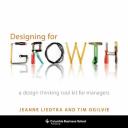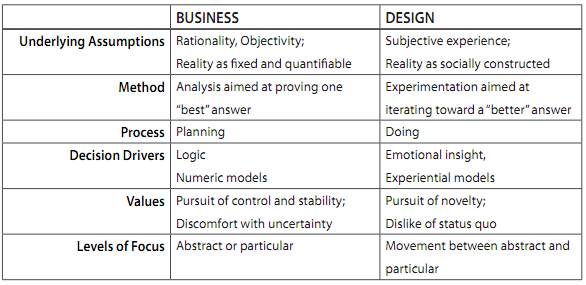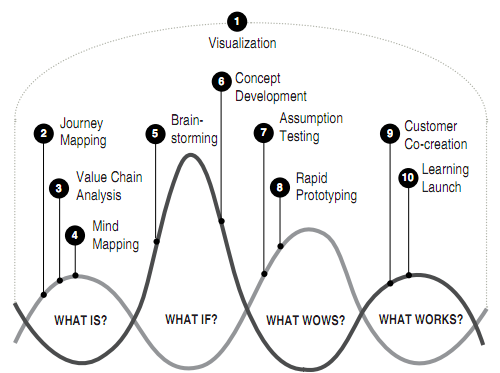April 15th, 2011
 The ethical consumer movement recognizes that people want to buy products and services that align with their values and moral beliefs. They want to do business with firms that demonstrate a high degree of social responsibility. Globally fair labor practices, low-environmental impact, no animal testing and other cause-related issues are at the heart of the matter.
The ethical consumer movement recognizes that people want to buy products and services that align with their values and moral beliefs. They want to do business with firms that demonstrate a high degree of social responsibility. Globally fair labor practices, low-environmental impact, no animal testing and other cause-related issues are at the heart of the matter.
Value alignment, moral beliefs and ethics are all powerful psychological stuff. That is why I was a bit surprised by the findings presented in a recent strategy+business article on Values versus Value. In it they argue that ethical products and services (with some notable exceptions) occupy a niche and more importantly the reality of values-based purchasing might be mostly a myth:
“Proponents of ethical consumerism want to believe that people’s socially oriented choices are somehow different — perhaps made at a higher level of consciousness — from their general product choices. This is a delusion. Product ethics are more important only when individuals, comparing such ethics to all the other things that have value to them, determine that they are more important. And our research shows that for many people, this is seldom the case.”
While the points raised in the article appear valid, I am concerned that they might be generated by a lack of good cognitive design rather than anything more fundamental. It is a bit like appreciating Art. It is often difficult to do with out proper context or orientation. The authors may agree:
“For more ethically oriented consumption to really take hold, the consumer needs to become a knowledgeable participant, not a reader of labels. Rather than relying on traditional market research techniques, firms need to help their existing and future consumers become more socially conscious in their purchasing.”
Bottom line – we need to use a more sophisticated view of moral cognition in the design of ethical products and services, if we want them to change the world.

Posted in Psychographics | No Comments »
April 13th, 2011
Self control is complex cognitive process that is fundamentally important for personal, professional and social success. We use self control to avoid temptations, delay immediate gratification for longer term rewards and achieve lasting behavior change.
 I have studied or implemented a little over 100 programs that make use of the cognition of self control to achieve behavior change. In each case, a key feature of the design included simple tactics or corrective actions participants used to avoid failures in self control. An interesting article on How Self Control Works, makes the same point. In reviewing Mischel’s famous marshmallow study, where children are asked to chose between receiving a marshmallow now or more later, researchers made a critical observation:
I have studied or implemented a little over 100 programs that make use of the cognition of self control to achieve behavior change. In each case, a key feature of the design included simple tactics or corrective actions participants used to avoid failures in self control. An interesting article on How Self Control Works, makes the same point. In reviewing Mischel’s famous marshmallow study, where children are asked to chose between receiving a marshmallow now or more later, researchers made a critical observation:
“Some children sat on their hands, physically restraining themselves, while others tried to redirect their attention by singing, talking or looking away. Moreover, Mischel found that all children were better at delaying rewards when distracting thoughts were suggested to them.”
Simple tactics that can be taught to others to improve self control. This is great news for anyone in the business of making behavior change (all of us). The key is to discover and teach simple corrective actions that help avoid failures in self control.
Very interested to hear from readers that have used this strategy. What teachable tactics for improved self control have you discovered?

Posted in Behavior Change | No Comments »
April 11th, 2011
 Over the last 30 years cognitive science has revealed a new and significantly different understanding of how minds work. Little of this new view has been factored into management, education, healthcare, communications and other cognition-intense activities. This creates opportunities for those interested in translating the science into new frameworks, methods and products aimed at creating more brain-smart practices. And the science continues to advanced – it is a moving target!
Over the last 30 years cognitive science has revealed a new and significantly different understanding of how minds work. Little of this new view has been factored into management, education, healthcare, communications and other cognition-intense activities. This creates opportunities for those interested in translating the science into new frameworks, methods and products aimed at creating more brain-smart practices. And the science continues to advanced – it is a moving target!
Take for example, the idea of dual-processing models of cognition that were popularized so well by the book, Blink: The Power of Thinking Without Thinking. The key idea is that we have two types of mental processes – automatic and deliberate – and most of what we do between our ears is automatic. Now more and more researchers are calling this simple distinction in question, claiming sub-classifications within both deliberate and automatic processing. One clear example is the work being done at Max Planck Institute. It is summarized nicely in Beyond Dual-Process Models.
The researchers focus on the automatic or intuitive processes and argue for four classes based on the cognitive process involved. The classes include association, matching, accumulation and constructive.
Such refinements suggest a number of possibilities for the design of education or decision-making applications. For example, the researchers talk about the different role of affect (emotion) in each model. Further, leveraging these sub forms of intuition might also be a way to lower the cognitive load of various activities. While these model are very much in the research phase, they signal the start of an important refinement in the science used by cognitive designers.

Posted in Design | No Comments »
April 9th, 2011
 One way to create preference for something is with lighting. We like things better when they are illuminated from the left. This is true for many things from paintings to advertisements. The position of the source of light also impacts cognitive task performance. For example, left side lighting improves our ability to identify shapes and perform visual search.
One way to create preference for something is with lighting. We like things better when they are illuminated from the left. This is true for many things from paintings to advertisements. The position of the source of light also impacts cognitive task performance. For example, left side lighting improves our ability to identify shapes and perform visual search.
The leftward lighting bias is strong enough to factor into a cognitive design. For evidence, take the article just published in the research journal, Laterality on Leftward Lighting in Advertisements. The authors claim:
”Overall, participants indicated that they preferred advertisements with leftward lighting and were more likely to purchase these products in the future than when the same products were lit from the right.”
The article provides an excellent synopsis of other leftward lighting biases with pointers into the literature.
Interested to hear from readers that have used this bias in an application.

Posted in Cognitive Bias | 5 Comments »
April 7th, 2011
 Design thinking, like quality thinking, process thinking, systemic thinking, lean thinking and the other “think like this” movements before it, is knocking on business’s door. It promises everything from more insightful strategy, to higher levels of innovation, truly agile operations and planned organizational change that works.
Design thinking, like quality thinking, process thinking, systemic thinking, lean thinking and the other “think like this” movements before it, is knocking on business’s door. It promises everything from more insightful strategy, to higher levels of innovation, truly agile operations and planned organizational change that works.
Design thinking as an early-stage management innovation is in a state of disarray. But that’s natural. Basic questions about definitions, methods and even if it works dominate the conversation. And these are the questions that you must answer to get traction in business. And they must be answered in just the right way. What is it? How do I do it? How do I know it works?
Indeed, when you look at the history of management innovation there is a clear signature to those that get traction and those that don’t. A manifesto is required that provides answers to the three questions that are powerful, simple and easy to retell. A compelling position that declutters the conversation and readies the management mind for action. While there are many fine books on design thinking for business, none come close to being a manifesto.
Manifestos are of special interest to cognitive designers that study management innovation and social change. They have a design that moves the heart and extends the mind. So I am always on the lookout for manifestos anxious to understand their content and deconstruct their design and figure out what makes them tick.
 Take for example the fourth coming book -Designing for Growth: a design thinking tool kit for managers. It shows some signs of being a manifesto. I base that on reading the first two chapters and looking at the cover art. The authors are good at creating cognitive dissonance and then resolving it in creative synthesis. This changes thinking.
Take for example the fourth coming book -Designing for Growth: a design thinking tool kit for managers. It shows some signs of being a manifesto. I base that on reading the first two chapters and looking at the cover art. The authors are good at creating cognitive dissonance and then resolving it in creative synthesis. This changes thinking.
For example, in the section on: Design and Business: A Match Made in Heaven – or Hell, they present a contrast table:

Runs deep and to the point but does not overload. They also present a 4-step method and 10 tools which they build up graphically over time with a grand finale of:

While too complex to share easily the wave form and some of the catch phrases (e.g. what WOWs) could vector.
Interested to hear from readers that are aware of manifestos on design thinking or have insights into the cognition of why they work.

Posted in Books, Design | 1 Comment »
April 4th, 2011
 Some objects, activities and rituals are naturally soothing. For example, a favorite shirt that is torn and tattered. They decrease stress and help us feel centered, relax and sometimes even happy. Understanding how these soothers work and injecting that capability in other designs is a great opportunity for cognitive designers. So I am always on the look out for scientific insights into how artifacts can relax us.
Some objects, activities and rituals are naturally soothing. For example, a favorite shirt that is torn and tattered. They decrease stress and help us feel centered, relax and sometimes even happy. Understanding how these soothers work and injecting that capability in other designs is a great opportunity for cognitive designers. So I am always on the look out for scientific insights into how artifacts can relax us.
Take for example, the study soon to be released in Psychological Science, Comfort Food Fights Loneliness.
“The study came out of the research program of his co-author Shira Gabriel, which has looked at social surrogates—non-human things that make people feel like they belong. Some people counteract loneliness by bonding with their favorite TV show, building virtual relationships with a celebrity or a movie character, or looking at pictures and mementos of loved ones. Troisi and Gabriel wondered if comfort food could have the same effect by making people think of their nearest and dearest.”
And they found that it did. As the quote above indicates, comfort food is not the only way we relieve social stress. TV, celebrity admiration, family photos and other social surrogates work too. From a cognitive design standpoint we need to understand the features and functions that cause soothing and why they work.

Posted in Psychographics | No Comments »
March 31st, 2011
 Xtranormal and Bing have teamed up to sponsor a contest for the best short online films with a decision making theme. Xtranormal is creator of Movie Maker an easy to use tool for producing online films just by typing. Microsoft just launched a new version of Bing positioning it as a “decision engine”. Here is the assignment:
Xtranormal and Bing have teamed up to sponsor a contest for the best short online films with a decision making theme. Xtranormal is creator of Movie Maker an easy to use tool for producing online films just by typing. Microsoft just launched a new version of Bing positioning it as a “decision engine”. Here is the assignment:
“Create a video that’s two minutes or less in one of three categories: Action, Horror or Romance, and remember that Bing is looking for movies about a “decision”. A winning video from each category will receive $2,500 and be eligible for the grand prize: $5000!! – and a new Xtranormal actor made in his or her likeness!”
While the money is modest, the real value to the winner might be the brand lift they get from being announced at the Bing party at the Tribeca Film Festival on April 26.
Fortunately, using Movie Maker to create a film is really easy. While the theme can include anything involving decisions (e.g. a decision you made or how to make better decisions) the judges might naturally favor something that resonates with Bing’s new brand:
“the decision engine that helps you make more informed decisions by providing the best search experience for topics that are important to you”
There is short video that describes decision-themed and lays downs the rules.
With an emphasis on decision-making, character design and on-line search experience this is clearly a cognitive design challenge.

Posted in Design, Events | No Comments »
March 29th, 2011
 Words are powerful because they activate mental models. Mental models provide context for making decisions, solving problems, learning and all sorts of cognitive tasks. Some words are much better at activating mental models than others. While it remains controversial exact which words are best, I am always on the look out for research on the cognitive power of words.
Words are powerful because they activate mental models. Mental models provide context for making decisions, solving problems, learning and all sorts of cognitive tasks. Some words are much better at activating mental models than others. While it remains controversial exact which words are best, I am always on the look out for research on the cognitive power of words.
Take for example the recent post on the Neuromarketing blog about Adjective Power. The post reminds us that a wise use of adjectives transforms mundane words or phrases such as “ham” into mentally stimulating phrases such as “hardwood smoked ham”. The post also reviews research that suggests that the impact of word choice is real. It drives revenue.
Even more interesting to cognitive designers is the list of what makes for a mentally stimulating word modifier. These include terms that are vivid, sensory, emotional, specific and branded. Given what we know about how minds work, this list makes a great deal of sense.
Check out the examples in the post such as “freshly cracked eggs”. Interested to hear from readers that have examples of communication designs that use this technique in other (non-food) domains.

Posted in Technique | No Comments »
March 26th, 2011
 Products and services that make it easy to give money in support of important causes (prosocial spending) make us feel good. I can give money to fight cancer in children when I make a purchase at the grocery store or send a text to help citizens in Japan cope with one of the biggest natural disasters of all time.
Products and services that make it easy to give money in support of important causes (prosocial spending) make us feel good. I can give money to fight cancer in children when I make a purchase at the grocery store or send a text to help citizens in Japan cope with one of the biggest natural disasters of all time.
This is good cognitive design- adding specific features and functions to existing products to generate a specific mental state. Prosocial spending engages the psychology of generosity, it makes us happy and gives us well being. But how much lift do we get? How universal is the impulse to be generous?
A recent working paper from Harvard Business School found that the emotional benefits of generosity are significant and universal or occur across cultures. They looked at survey data from a 136 countries and did a causal study in two countries to conclude:
“In contrast to traditional economic thought—which places self-interest as the guiding principle of human motivation—our findings suggest that the reward experienced from helping others may be deeply ingrained in human nature, emerging in diverse cultural and economic contexts.”
This is a strong signal to cognitive designers. Enabling opportunities for prosocial spending – or other forms of generosity- will generate significant psychological impact for most groups.

Posted in Examples, Psychographics | 1 Comment »
March 24th, 2011
 When predicting outcomes most people tend to overestimate the chances of a positive outcome and underestimate the chances of a negative outcome. This optimism bias is at the root of gambling fallacies and shapes an array of predictions ranging from ill effects of smoking to corporate earning estimates and how well you will do on a test.
When predicting outcomes most people tend to overestimate the chances of a positive outcome and underestimate the chances of a negative outcome. This optimism bias is at the root of gambling fallacies and shapes an array of predictions ranging from ill effects of smoking to corporate earning estimates and how well you will do on a test.
For cognitive designers working in the area of decision support, the overconfidence bias is a tricky issue. You want to mitigate its effect but not make your solution too conservative.
One way of mitigating its effects was recently uncovered by researchers at Duke University Health Center. Using brain scanning studies they found that the overconfidence bias is magnified when decision maker do not get enough sleep.
“The scientists showed, using a functional MRI, that a night of sleep deprivation leads to increased brain activity in brain regions that assess positive outcomes, while at the same time, this deprivation leads to decreased activation in the brain areas that process negative outcomes.”
This suggest making economic decision early in the day or when fully rested may help to avoid the effects of the optimism bias.

Posted in Cognitive Bias | No Comments »
 The ethical consumer movement recognizes that people want to buy products and services that align with their values and moral beliefs. They want to do business with firms that demonstrate a high degree of social responsibility. Globally fair labor practices, low-environmental impact, no animal testing and other cause-related issues are at the heart of the matter.
The ethical consumer movement recognizes that people want to buy products and services that align with their values and moral beliefs. They want to do business with firms that demonstrate a high degree of social responsibility. Globally fair labor practices, low-environmental impact, no animal testing and other cause-related issues are at the heart of the matter.










